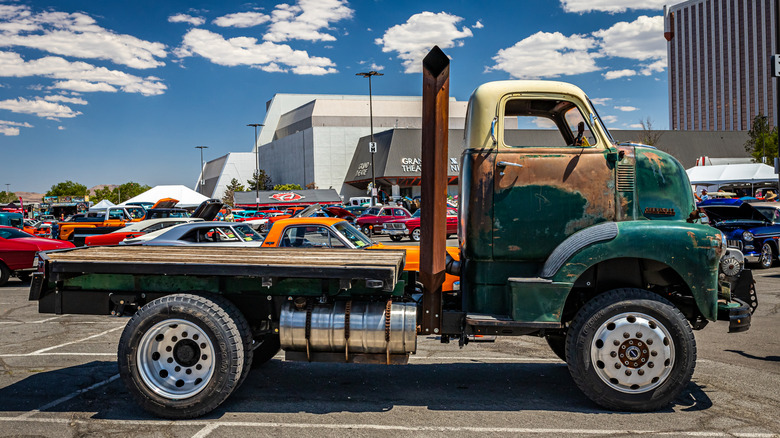Why You Shouldn't Use A Semi-Truck As A Personal Vehicle (Even If It's Legal)
Pickup trucks in the U.S. are getting bigger and taller with each generation. With hoods on some models now up around adult eye level, the oversized proportions are one of the worst car trends we've seen. It might leave you wondering whether you should skip the pickup altogether and just drive a semi-truck around as a personal vehicle instead. As it turns out, there are a number of reasons why this is a bad idea.
While in some states it is legal to drive a large, commercial Class 8 semi-truck for personal conveyance, in others it isn't, and the rules around what is permissible and what's not are complex. Not only does cruising around in a semi-truck increase your risk of running afoul of the law, it limits where and how you can drive, especially if traveling interstate. There are other downsides, too. The physical size of a semi-truck can exclude you from getting in and out of — and in some cases, under — urban infrastructure, including under low-clearance overpasses and your garage.
The upfront costs of a rig are as enormous as the thing itself, with the average cost of a new, basic model semi-truck kicking in at around $150,000 in 2025, and heading northwards from there to $275,000 for a high-end custom. While used rigs can be found for under $10,000, their prices can also range up to six figures, depending on the type of truck, its brand, age, mileage, and condition.
Size matters
If the truck weighs in under 26,000 lbs, you don't need a commercial driver's license (CDL) to pilot it, as long as it is being driven as a private vehicle and not for work. In most states, you do not need a CDL to drive a semi for personal use. But if you're not hauling payloads, running costs add up fast. Registration fees generally vary with weight, the logic being that heavier vehicles create more wear and tear on our roads. Which means a heavy semi-truck will likely cost you more to register than a regular pickup, even when licensing it as a personal vehicle.
And then there's the fuel economy — or lack of it. The average truck manages only 7 to 8 mpg on the open highway. Newer rigs are generally more economical, but even the most fuel-efficient semi-trucks struggle to top 10 mpg, even on test tracks, in optimal conditions. Driving a bobtail truck instead of a box truck — that is, without a trailer attached — uses less fuel, but the altered weight distribution raises safety and handling concerns.
And because it is designed to move heavy loads up steep gradients, a semi-truck may have anywhere between 9 and 18 gears, giving you a real workout on the stick, even when skipping gears. Driving an automatic is less tiresome, but you are still paying for a complex gearbox with around three times as many gears as you actually need.
The looks and the lifestyle
Call them enthusiasts or call them eccentrics, there are always those who do things for reasons other than practicality. The online trucking forums are full of tales from former truckers who, despite the obvious encumbrances, own a rig that meets their lifestyle needs, whether it's hauling horses and hay, or hooking up an RV trailer to turn their 18-wheeler into a mobile home. On their blog, 18wheelrv.com, one such couple explains how, once they began using their working Freightliner to tow an RV, they never looked back. They highlight the Freightliner's power, braking ability, comfort, and visibility as big advantages for towing a heavy fifth-wheel RV, while also enjoying the distinctive style of the setup.
Much like classic car culture, there is a whole world of people out there who drive classic semi-trucks as personal vehicles. Most owner-operators of collectible commercial trucks are current or former truckers, who use them for club meets, parades, and the occasional Sunday breakfast run. The pastime is costly: while an old semi-truck can be picked up cheaply, an owner can easily spend $200,000 on its restoration. Judging by these best-looking trucks from the 1950s, we can see why.


